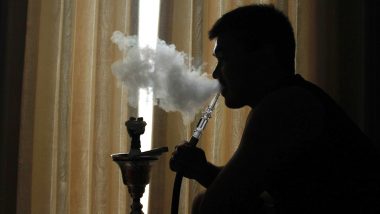Washington [USA], May 25: Electric hookahs are just as harmful has traditional charcoal-based ones, a recent study suggests. Waterpipe tobacco smoking, otherwise known as "hookah" or "shisha," is becoming increasingly popular worldwide, especially among youth. Traditional hookahs burn charcoals as a heat source, but recently, electrical heating elements (EHEs) have been introduced to the market. Reinforced by product advertising and package labelling, many hookah smokers believe that EHEs are less harmful than charcoal.
According to a recent study, although EHEs reduce some toxicants, they increase others. In traditional hookahs, smokers burn charcoal on top of a tobacco preparation known as ma'ssel, a mixture of tobacco, glycerin, water, and flavourings. The resulting smoke bubbles through the water at the bottom of the pipe before being inhaled through a tube by the smoker. Findings of the study were published in the Journal of Chemical Research in Toxicology. Smoking Tobacco Through Hookah is Harmful for Heart, Reveals Study.
Previous studies have shown that charcoal contributes most of the harmful polycyclic aromatic hydrocarbons (PAHs) and carbon monoxide found in hookah smoke. Therefore, manufacturers have developed EHEs for hookahs, in some cases advertising them as "toxicant-free" or "carbon monoxide-free. "A team of researchers at the American University of Beirut wanted to investigate these claims by comparing the emissions of several major toxicants from waterpipes using EHEs or charcoal. With an automatic smoking machine, the researchers examined emissions from a hookah using charcoal or one of three commercially available EHEs as the heat source.
They found that the EHEs reduced carbon monoxide and PAH emissions by 90 per cent and 80 per cent, respectively. However, emissions of acrolein, a highly reactive irritant thought to be responsible for nearly all non-cancer respiratory diseases in cigarette smokers, was several orders of magnitude higher with EHE use, compared with charcoal use. E-Cigarettes and Flavoured Hookah: Commerce Ministry Asks Health Ministry to Frame Law to Ban Manufacture and Sale in India.
In addition, levels of some other volatile aldehydes were higher in EHE-produced smoke than in charcoal-produced smoke. Aerosolised particulate matter and nicotine yield were similar among the heating sources. These results suggest that marketing EHEs as safer than charcoal might be misleading, the researchers say.
(This is an unedited and auto-generated story from Syndicated News feed, LatestLY Staff may not have modified or edited the content body)













 Quickly
Quickly




















